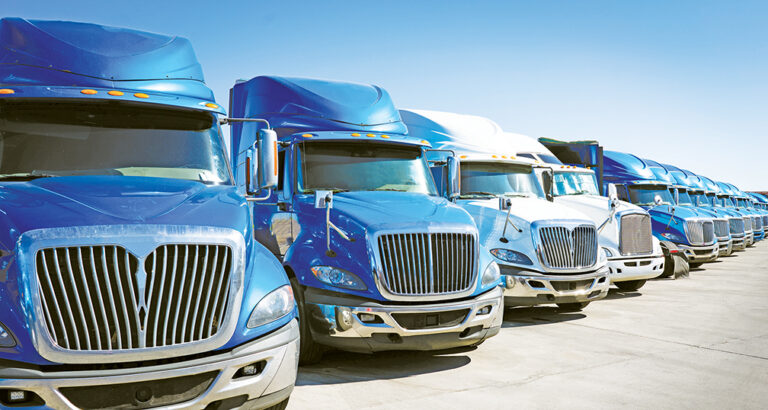U.S. sales of new Class 8 trucks remained above the 20,000 threshold for the third consecutive month in July, reaching 20,919 according to data received from ACT Research. In 2021, three total months exceeded the 20,000 mark, including December, which is typically the biggest sales month of the year.
This year, sales lagged behind last year’s pace until finally catching up in June and then pulling ahead in July. For the first seven months of 2022, OEMs reported sales of 136,165 on the U.S. market compared to 131,571 at the same time last year — an increase of 4,594 trucks (3.5%).
Compared with an exceptionally strong June, however, July sales dropped by 1,931 units for a decline of 7.6% month over month. Contrasted with July 2021 however, sales increased by 20.8% with delivery of an additional 3,595 trucks in July this year. Note that June is the final month of the second quarter; quarter-ending months are typically strong as carriers adjust their numbers in preparation for SEC filings.
Clearly, truck manufacturers are finding solutions for supply chain issues that have held back production since the COVID-19 pandemic began. However, OEMs are still running behind their maximum output levels, so supply chain problems still exist.
Despite moving more new Class 8 trucks in the past three months, a North American backlog of over 200,000 units remains. Some of those — about 20,000 — are orders for 2023 models. The OEMs, however, won’t be able to finish the orders for 2022.
“There are about 135,000 build slots left for this year,” said Kenny Vieth, president and senior analyst at ACT Research. “There are about 180,000 orders for trucks this year, so there are about 45,000 more orders to be built than they can build before they change over to the 2023 models.”
North America Class 8 net orders fell to 11,400 units, according to a release by ACT. A large reason that may be the manufacturers themselves declining to take further orders for 2023. The current backlog already stretches well into 2023, and with current inflation rates, it is undoubtedly difficult to predict the price of a new truck a year from now. Builders are understandably reluctant to lock in truck orders at today’s pricing, knowing that their costs for parts and materials will certainly rise.
While inflation is driving trucking costs skyward, freight rates are going the opposite direction. Spot rates continue to fall, according to DAT Trendlines. The service reported that dry van rates fell 1.7% in July from June and have declined 3% compared to July 2021. Refrigerated spot rates have fallen further, down 1.6% from June but down 4.3% compared to July 2021. Flatbed July rates fell 4.3% from June but are still 6.1% ahead of July 2021 rates. Weekly reports so far in August show further declines.
Contract rates typically follow spot rates, but with a delay of months; average contract rates are now falling too.
While economists debate whether the economy is in recession, ACT’s Vieth thinks it’s already here for trucking.
“Our call was that we are in a freight recession, starting in the second quarter,” he said.
One industry factor that isn’t following the usual course is order cancellations. Typically, when rates drop, buyers start cancelling orders to avoid buying trucks without enough freight to support them.
“The last four months, I can’t recall a four month period with lower cancellations without going back to like 2010 when nobody was ordering trucks and there were no trucks in the backlog,” he said.
ACT is predicting an economic recession during the first half of 2023. Whether the recession is already here or is coming in six months, buyers haven’t been scared away from ordering new trucks.
As usual, Freightliner led all sellers with July U.S. sales of 7,855, according to data received from Wards Intelligence. That number represents a decline of 3.4% from June sales but a 34.4% increase over July 2021. In July, Freightliner sold 38.3% of the Class 8 trucks sold in the U.S.
Freightliner sibling Western Star was the only OEM to sell more Class 8 trucks in July than June, although the manufacturer’s market share is considerably smaller at 2.7%. The company reported sales of 552 trucks in July compared with 450 in June for an increase of 22.7%.
International sales of 2,229 were down 23.8% from June sales of 2,929. The company also represents the only OEM that saw worse sales numbers in July than in the same month a year earlier, selling 394 fewer Class 8 units for a 15% decline. International was responsible for 10.9% of Class 8 sales in July.
Volvo’s sales of 2,123 trucks in July was a decline of 20.8% from June’s 2,679. However, July 2021 was a poor month for the OEM with just 888 Class 8 trucks sold, so July 2022 represents a whopping 139.1% increase.
Sales of Volvo-owned Mack Class 8 trucks declined 17% in July, dropping from June’s 1,560 to 1,295. Compared with July 2021, Mack sales increased by a modest 43 trucks (3.4%). In July, Mack sales represented 6.3% of the market while sibling Volvo took 10.3%
Kenworth reported sales of 3,067 trucks, down 4% from June’s 3,194 but up slightly (1.2%) from the 3,032 trucks sold in July 2021. Kenworth sales took 15% of the U.S. Class 8 market in July. Peterbilt sales reached 3,392 in July, down 0.8% from June’s 3,418 and up 24% from July 2021 sales of 2,735. Peterbilt took 16.5% of the U.S. Class 8 market in July. Together, the PACCAR siblings were responsible for 31.5% of the market.
Parts and components, especially semiconductors, seem to be in greater supply now than earlier in the year but supply chain issues aren’t over yet. Carriers are still profiting from the higher freight rates and are likely to keep investing in new equipment as long as there is money to make.
Possible headwinds are inflationary pressures, including increasing interest rates that will impact purchasing power for those who finance equipment purchases, continued supply chain issues, and falling freight rates.
Cliff Abbott is an experienced commercial vehicle driver and owner-operator who still holds a CDL in his home state of Alabama. In nearly 40 years in trucking, he’s been an instructor and trainer and has managed safety and recruiting operations for several carriers. Having never lost his love of the road, Cliff has written a book and hundreds of songs and has been writing for The Trucker for more than a decade.















